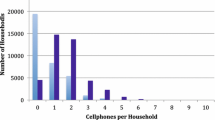Abstract
The competitive environment in long-distance telecommunications markets changed considerably with the divestiture of AT&T in 1982. A variety of providers appeared, offering myriad services. In this environment, customer selection of preferred long-distance carrier became more complicated and more important.
In this paper, we analyze and quantify the determinants of this choice. To our knowledge, this focus is distinct. By contrast, the literature to date has analyzed the behavioral determinants of calling volume (local and long-distance) and the selection of local service options.
In our analysis, we allow the alternative carriers to differ in terms of tariffs, reputation, quality, access, and specialized customer services. We quantify the interactive effects of these carrier attributes and customer demographics upon the selection of carrier. Price and income elasticities are estimated. A distinguishing feature of our analysis is that it examines behavioral differences among households in equal-access and unequal-access areas. We find that households assured of the convenience of 1 + dialling for their chosen carrier in equal-access areas display more rational and sophisticated decision making. On the other hand, households in unequal-access areas display greater status quo effects in their decision making.
Similar content being viewed by others
References
Amemiya, T. 1981. “Qualitative Response Models: A Survey.”Journal of Economic Literature 19(4: 483–536.
Ben-Akiva, M. and L. Lerman. 1985.Discrete Choice Analysis: Theory and Application to Travel Demand. Cambridge: MIT Press.
Berndt, E. R. and M. S. Khaled. 1979. “Parametric Productivity Measurement and Choice Among Flexible Functional Forms.”Journal of Political Economy 87(6): 1220–1245.
Blackorby, C., D. Primont, and R. R. Russell. 1977. “On Testing Separability Restrictions with Flexible Functional Forms.”Journal of Econometrics 5(2): 195–209.
Cameron, T. 1985. “A Nested Logit Model of Energy Conservation Activity by Owners of Existing Single Family Dwellings.”The Review of Economics and Statistics 67(3): 205–211.
Changing Times. 1986. “Long distance: Connect With the Right Company.” (February): 37–39.
Christensen, L. R., D. W. Jorgenson, and L. J. Lau. 1975. “Transcendental Logarithmic Utility Functions.”American Economic Review 65(3): 367–383.
Dubin, J. and D. McFadden. 1984. “An Econometric Analysis of Residential Electric Appliance Holdings and Consumption.”Econometrica 52(2): 345–362.
Fortune Magazine. 1989. “Was Breaking up AT&T a good Idea?” (January).
Hanemann, W. M. 1984. “Discrete/Continuous Models of Consumer Demand.”Econometrica 52(3): 541–561.
Hartman, R. S. 1982. “A Note on the Use of Aggregate Data in Individual Choice Models: Discrete Consumer Choice Among Alternative Fuels for Residential Appliances.”Journal of Econometrics 18(3): 313–335.
Hartman, R. S. 1983. “The Estimation of Short-Run Household Electricity Demand Using Pooled Aggregate Data.”Journal of Business and Economic Statistics 1(2): 127–135.
Hartman, R. S. 1984. “The Importance of Technology and Fuel Choice in the Analysis of Utility-Sponsored Conservation Strategies for Residential Water Heating.”The Energy Journal 5(3): 99–118.
Hartman, R. S. 1988. “Self-Selection Bias in the Evaluation of Voluntary Energy Conservation Programs.”Review of Economics and Statistics 70(3): 448–458.
Hartman, R. S. 1989a. “An Empirical Model of Product Design and Pricing Strategy.”International Journal of Industrial Organization 7(4): 419–436.
Hartman, R. S. 1989b. “Hedonic Methods for Evaluating Product Design and Pricing Strategies.”Journal of Economics and Business 41(3): 197–212.
Hartman, R. S., M. J. Doane, and C. K. Woo. 1991.“Consumer Rationality and the Status Quo.”Quarterly Journal of Economics 106(1): 141–162.
Hausman, J. 1979. “Individual Discount Rates and the Purchase and Utilization of Energy-Using Durables.”Bell Journal of Economics 10(2): 33–54.
Hausman, J. 1978. “Specification Tests in Econometrics.”Econometrica 46(6): 1251–1271.
Hausman, J. and D. McFadden. 1984. “Specification Tests for the Multinomial Logit Model.”Econometrica 52(5): 1219–1240.
Heckman, J. 1978. “Dummy Endogenous Variables in a Simultaneous Equation System.”Econometrica 46(6): 931–959.
Irwin, M. R. 1986. “Telecommunications Industry.” InThe Structure of American Industry, edited by Walter Adams. Macmillan.
MacAvoy, P.W. and K. Robinson. 1983. “Winning by Losing: The AT&T Settlement and Its Impact on Telecommunications.”Yale Journal on Regulation 1(1): 1–42.
Maddala, G. 1983.Limited-Dependent and Qualitative Variables in Econometrics. Cambridge University Press.
Manski, C. and S. Lerman. 1977. “The Estimation of Choice Probabilities from Choice Based Samples.”Econometrica 45(8): 1977–1988.
Manski, C. and D. McFadden. 1981. “Alternative Estimators and Sample Design for Discrete Choice Analysis.” InStructural Analysis of Discrete Data with Econometric Applications, edited by C. Manski and D. McFadden. Cambridge: MIT Press.
McFadden, D. 1978.“Modelling the Choice of Residential Location.” InSpatial Interaction Theory and Planning Models, edited by A. Karlqvist, L. Lundqvist, F. Snickars and J. Weibull. Amsterdam: North Holland.
Pacey, P. L. 1983. “Long Distance Demand: A Point-to-Point Model.”Southern Economic Journal 49(4): 1094–1103.
Park, R. E., B. M. Mitchell, B. M. Wetzel, and J. H. Alleman. 1983. “Charging for Local Telephone Calls.” Journal of Econometrics 22(4): 339–364.
Samuelson, W. and R. Zeckhauser. 1986. “Status Quo Bias in Individual Decision Making.” Unpublished Paper, Boston University.
Small, K. A. and H. S. Rosen. 1981. “Applied Welfare Economics with Discrete Choice Models.”Econometrica 49(1): 105–130.
Train, K. E., D. L. McFadden and M. Ben-Akiva. 1987. “The Demand for Local Telephone Service: A Fully Discrete Model of Residential Calling Patterns and Service Choice.”Rand Journal of Economics 18(1): 109–123.
Taylor, L. D. 1980.Telecommunications Demand. Boston: Ballinger.Time Magazine. 1986. “Ratifying a Winner in the Phone Vote.” (August 25th).
Wall Street Journal. 1986. “Special Report on Telecommunications.” (February 24th).
Author information
Authors and Affiliations
Rights and permissions
About this article
Cite this article
Hartman, R.S., Naqvi, Z.F. Estimation of household preferences for long distance telecommunications carrier. J Regul Econ 6, 197–220 (1994). https://doi.org/10.1007/BF01065750
Issue Date:
DOI: https://doi.org/10.1007/BF01065750




